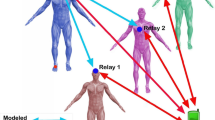Abstract
The first results achieved in the French ANR (National Research Agency) project BANET (Body Area NEtwork and Technologies) concerning the channel characterization and modeling aspects of Body Area Networks (BANs) are presented (part II). A scenario-based approach is used to determine the BAN statistical behavior, trends, and eventually models, from numerous measurement campaigns. Measurement setups are carefully described in the UWB context. The numerous sources of variability of the channel are addressed. A particular focus is put on the time-variant channel, showing notably that it is the main cause of the slow fading variance. Issues related to the data processing and the measurement uncertainties are also described.




























Similar content being viewed by others
Notes
Due to local (small-scale) inhomogeneities of the body.
Typically as a lower bound, as shadowing and selective fading effects should be added.
Dual-fed monopole in microstrip technology and planar balanced dipole.
References
Roblin Ch, Laheurte J-M, D'Errico R, Gati A, Lautru D, Alvès T, Terchoune H, Bouttout F “Antenna design and channel modelling in the BAN context—part I: antennas,” submitted to Annals of Telecommunications, “Special issue on Body Area Networks Applications and Technologies,” Springer
Yazdandoost KY, Sayrafian-Pour K (2009) IEEE P802.15-08-0780-09-0006: channel model for body area network (BAN), IEEE 802.15 Working Group Document, April
Zasowski T, Althaus F, Wittneben A, Troster G (2003) UWB for noninvasive wireless body area networks: channel measurements and results, UWBST
Obayashi S, Zander J (1998) A body-shadowing model for indoor radio communication environments. IEEE Trans Antennas Propag 46(6):920–927
King HE (1975) Characteristics of body-mounted antennas for personal radio sets. IEEE Trans Antennas Propag AP23:242–244
Andersen JB, Hansen F (1977) Antennas for VHF/UHF personal radio: a theoretical and experimental study of characteristics and performance. IEEE Trans Veh Technol 26(4):349–357
Debye P (1929) Polar molecules, edition. New York, The chemical catalog
Cole KS, Cole RH (1941) Dispersion and absorption in dielectrics. I. Alternating current characteristics. J Chem Phys 9:341–351
Foster KR, Schwan HP (1989) Dielectric properties of tissues and biological materials: a critical review. Crit Rev Biomed Eng 17(1):26–104
Durney CH, Massoudi, Iskander MF (1986) Radiofrequency radiation dosimetry handbook. Brooks Air Force Base-USAFSAM-TR-85-73, San Antonio, TX
Zasowski T, Meyer G, Althaus F, Wittneben A (2006) UWB signal propagation at the human head. IEEE Trans Microwave Theor Tech 54(4):1836–1845
Roy SV, Oestges C, Horlin F, De Doncker Ph (2007) On-body propagation velocity estimation using ultra-wideband frequency-domain spatial correlation analysis. Electron Lett 43(25), Dec
(2006) IEEE 802.15.4a channel model—final report, Nov
Molisch AF, Cassioli D, Chong C, Emami S, Fort B, Kannan A, Karedal J, Kunish J, Schantz HG (2006) A comprehensive standardized model for ultrawideband propagation channels. IEEE Trans Antennas Propag 54(11):3151–3166
Zasowski T, Meyer G, Althaus F, Wittneben A (2005) Propagation effects in UWB body area networks, 2005 IEEE International Conference on Ultra-Wideband, Zurich, 5–8 Sept
Fort A, Desset C, De Doncker P, Wambacq P, Van Biessen L (2006) An ultra-wideband body area propagation channel model–from statistics to implementation. IEEE transactions on MTT 54(4):1827–1835
Fort A, Desset C, Ryckaert J, De Doncker P, Van Biessen L, Donnay S (2005) Characterization of the ultra wideband body area propagation channel, 2005 International Conference on Ultra-Wideband, Zurich, 5–8 Sept
Fort A, Ryckaert J, Desset C, De Doncker P, Wambacq P, Van Biessen L (2006) Ultra-wideband channel model for communication around the human body. IEEE JSAC 24(4):927–933, April
Ryckaert J, De Doncker P, Meys R, de Le Hoye A, Donnay S (2004) Channel model for wireless communication around human body. Electron Lett 40(9):543–544
Hall PS, Hao Y, Nechayev YI, Constantinou C, Parini C, Kamarudin MR, Salim TZ, Hee DTM, Dubrovka R, Owadally AS, Song W, Serra A, Nepa P, Gallo M, Bozzetti M (2007) Antennas and propagation for on-body communication systems. IEEE AP Mag 49(3):41–58
Hall PS, Hao Y (eds) (2006) Antennas and propagation for body-centric wireless communications. Artech House, London, p 314
Cotton SL, Scanlon WG (2006) A statistical analysis of indoor multipath fading for a narrowband wireless body area network. Personal Indoor and Mobile Radio Communications, IEEE
Cotton SL, Scanlon WG (2007) A higher order statistics for lognormal small-scale fading in mobile radio channels. IEEE Antenn Wireless Propag Lett 6:540–543
Roblin C, D'Errico R, Gorce JM, Laheurte JM, Ouvry L (2009) Propagation channel models for BANs: an overview, COST 2100, 16-18/02/2009, Braunschweig, Germany
Ghannoum H, Bories S, D'Errico R (2006) Small-size UWB planar antenna and its behaviour in WBAN/WPAN applications. IEE Seminar on Ultra Wideband Systems, Technologies and Applications, London, Apr. 20
ICNIRP Guidelines (1998) Guidelines for limiting exposure to time-varying electric, magnetic, and electromagnetic fields (up to 300 GHz). Health Phys 74(4):494–522
Acknowledgements
Authors would like to thank Daniel Toledano and Lara Traver for their contribution to measurement campaigns at ENSTA-ParisTech, Serge Bories for his initial contribution and Laurent Ouvry—from CEA-Leti—for his wise scientific advice, and Amir Yousuf, Franscesco Guidi, Enrique De Mur, and Nizar Malkiya for their help at ENSTA-ParisTech.
Author information
Authors and Affiliations
Corresponding author
Rights and permissions
About this article
Cite this article
Roblin, C., Laheurte, JM., D’Errico, R. et al. Antenna design and channel modeling in the BAN context—part II: channel. Ann. Telecommun. 66, 157–175 (2011). https://doi.org/10.1007/s12243-010-0231-x
Received:
Accepted:
Published:
Issue Date:
DOI: https://doi.org/10.1007/s12243-010-0231-x




